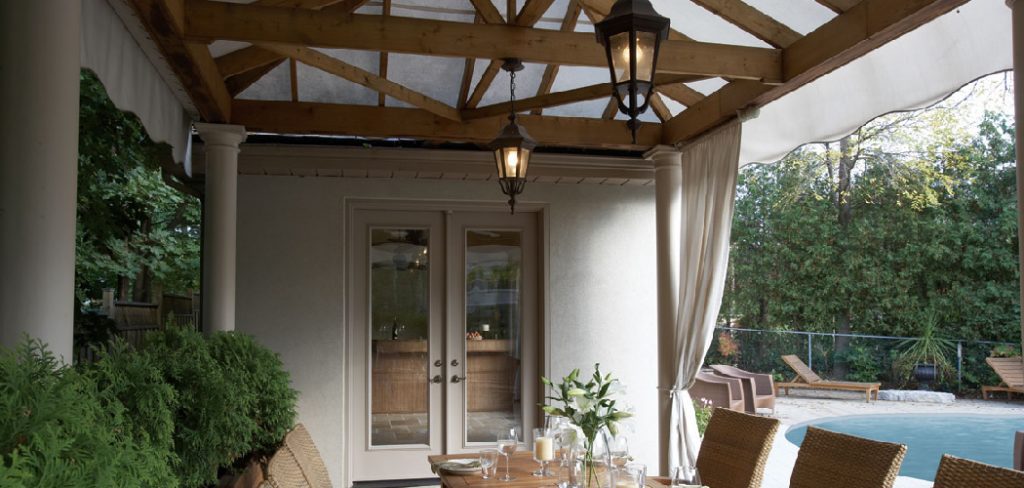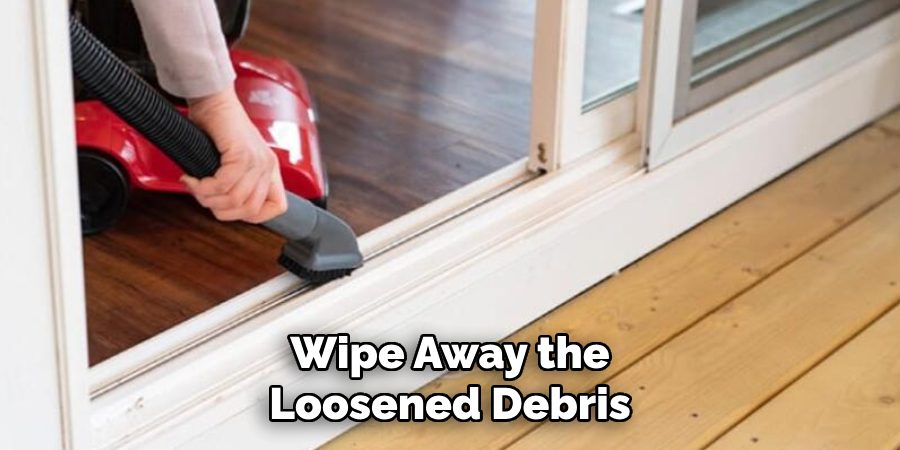Keeping your patio door tracks clean is essential for ensuring smooth operation and prolonging the lifespan of your doors. Over time, dirt, debris, and grime can accumulate in the tracks, causing the doors to stick or become difficult to move. Regular maintenance not only improves functionality but also enhances the overall appearance of your patio area.

This guide explores the key aspects of how to clean patio door tracks. By following a few simple steps, you can keep your patio door tracks in excellent condition.
Importance of Keeping Patio Door Tracks Clean
Clean patio door tracks are crucial for ensuring the proper functionality of your sliding doors. When dirt and debris build up in the tracks, they can obstruct the door’s movement, making it challenging to open or close. This added friction not only causes inconvenience but can also lead to excessive wear and tear on the door mechanism over time.
Additionally, neglecting the cleanliness of the tracks can attract pests or cause moisture buildup, which may result in rust or damage. By regularly cleaning the tracks, you can avoid costly repairs, improve energy efficiency by maintaining a proper seal, and enjoy the ease of smoothly functioning patio doors.
Why Patio Door Tracks Get Dirty
Patio door tracks are prone to getting dirty due to their frequent exposure to various environmental factors and daily use. Dirt, dust, and outdoor debris such as leaves or sand can easily accumulate in the tracks, especially if the door leads to a garden or backyard. Foot traffic in and out of the patio exacerbates the problem, as people often unintentionally bring in small particles that settle in the tracks.
Additionally, moisture from rain or humidity can mix with the debris, creating grime that becomes more difficult to remove over time. Pets may also contribute to the mess by shedding hair or tracking dirt into the area. Without regular cleaning, this buildup not only looks unsightly but can also compromise the functionality of the door.
Tools and Supplies Needed for Cleaning
To effectively clean patio door tracks, you’ll need a few essential tools and supplies. Here’s a list of items to gather before you start:
- Vacuum Cleaner: Use a vacuum with a crevice tool attachment to remove loose dirt and debris from the tracks.
- Soft Brush or Toothbrush: A small brush helps scrub away stubborn grime from tight corners and crevices.
- Cleaning Cloths or Rags: These are useful for wiping down the tracks during the cleaning process.
- Mild Detergent or Cleaning Solution: Choose a non-abrasive cleaner to avoid damaging the tracks.
- Warm Water: Combine with the cleaning solution to loosen dried or sticky debris.
- Screwdriver (Optional): Use this to gently pry off weather stripping or panels if needed for deeper cleaning.
- Dry Towel: For drying the tracks thoroughly after cleaning to prevent moisture buildup.
- Lubricant (Silicone-Based): Apply this after cleaning to ensure smooth sliding of the door and prevent friction.
Having these tools and supplies on hand will make the cleaning process more efficient and help you achieve the best results.
10 Methods How to Clean Patio Door Tracks
1. Vacuum Loose Debris First

Before deep cleaning, use a vacuum with a narrow nozzle attachment to remove loose dirt, pet hair, and debris from the tracks. Running the vacuum along the length of the tracks helps minimize mess before applying cleaning solutions, making the process more efficient.
2. Use a Soft-Bristled Brush for Scrubbing
A soft-bristled brush, such as an old toothbrush or a dedicated track-cleaning brush, is perfect for loosening stubborn dirt. Scrub along the grooves and edges of the tracks to dislodge built-up grime before wiping it away with a cloth.
3. Apply a Baking Soda and Vinegar Solution
Baking soda and vinegar create a natural, powerful cleaning reaction. Sprinkle baking soda along the tracks and pour vinegar over it. Let it sit for 10-15 minutes to break down dirt and stains before scrubbing and wiping the tracks clean with a damp cloth.
4. Use Warm Soapy Water for Regular Maintenance
For routine cleaning, a mixture of warm water and mild dish soap is effective. Dip a sponge or cloth into the soapy solution and wipe along the tracks. Rinse with a clean damp cloth to remove soap residue and prevent dirt from sticking.
5. Try a Steam Cleaner for Deep Cleaning
A handheld steam cleaner can break down tough grime without chemicals. Direct the steam nozzle along the tracks, allowing the heat to loosen dirt. Wipe away the loosened debris with a microfiber cloth or paper towel.

6. Use a Butter Knife Wrapped in a Cloth for Tight Spaces
If dirt is lodged in narrow crevices, wrap a damp cloth around a butter knife and slide it along the grooves. This technique helps reach tight spots where a brush or vacuum might not be effective.
7. Apply WD-40 to Loosen Stubborn Dirt
For heavily soiled tracks, spray a small amount of WD-40 onto the dirt and let it sit for a few minutes. Use a cloth or brush to wipe away the grime. WD-40 also acts as a lubricant, helping the doors slide smoothly.
8. Use a Cotton Swab for Precision Cleaning
For small areas that are difficult to reach, dip a cotton swab in a cleaning solution and use it to clean the corners and edges of the tracks. This method is especially useful for detailed cleaning and removing built-up grime.
9. Dry the Tracks Thoroughly to Prevent Mold
After cleaning, ensure the tracks are completely dry using a microfiber cloth or paper towel. Moisture left behind can lead to mold and mildew growth, causing further issues.
10. Lubricate the Tracks for Smooth Sliding
Once the tracks are clean and dry, apply a silicone-based lubricant to enhance sliding efficiency. Avoid using oil-based lubricants, as they can attract dirt and cause buildup over time.

Maintenance and Upkeep
Regular maintenance and upkeep of your patio door tracks are essential to ensure their long-term functionality and smooth operation. Start by incorporating a monthly cleaning routine to prevent debris buildup and grime accumulation. This can involve vacuuming the tracks and wiping them down with warm soapy water. Additionally, inspect the tracks for any signs of damage, such as cracks or warping, as these can affect the performance of your door and may require repairs or replacement.
Lubrication plays a key role in maintaining the ease of sliding. Apply a silicone-based lubricant every few months or as needed to reduce friction and wear on the tracks. Avoid using oil-based products, as they tend to attract more dirt over time. If you live in an area with extreme weather conditions, check the tracks more frequently for any moisture, rust, or seasonal debris that might need attention.
Lastly, ensure that the weather stripping around the tracks remains intact and replace it when necessary to maintain a proper seal and energy efficiency. By staying consistent with maintenance efforts, you can extend the lifespan of your patio doors and continue enjoying their seamless operation for years to come.
Troubleshooting Common Issues
Despite regular cleaning and maintenance, you may encounter common issues with your patio door tracks. Here’s how to identify and address them effectively:
1. Sticking or Hard-to-Slide Doors
If your patio door is difficult to slide, the tracks may be dirty or lacking lubrication. Begin by cleaning the tracks thoroughly using the methods outlined above, ensuring all debris is removed. Once clean and dry, apply a silicone-based lubricant to reduce friction. If the issue persists, check for warped tracks or damage to the rollers, which may need replacement.
2. Noisy or Squeaky Movement
A squeaky door is often a sign of insufficient lubrication. Inspect the tracks and rollers for dirt buildup, clean them, and lubricate with a silicone-based product. Avoid using oil-based lubricants that attract more dirt. If noise continues, check for damaged roller wheels as these may need to be repaired or replaced.
3. Misaligned Door
If your door does not open or close smoothly, it may be misaligned. Inspect the rollers at the bottom of the door and adjust their height using a screwdriver to achieve proper alignment. Loosen or tighten the roller screws as needed until the door slides evenly within the frame.
4. Water Build-Up in Tracks
Water accumulation can occur due to clogged drainage holes or poor weather stripping. Clear out any debris from drainage holes using a small brush or a toothpick to allow water to flow freely. Inspect the weather stripping and replace it if it appears worn or damaged to prevent water from seeping into the tracks.

5. Rust or Corrosion
Tracks exposed to moisture over time may develop rust or corrosion. Use a wire brush or sandpaper to gently remove rust from the surface. Once cleaned, wipe the area with a damp cloth and dry it thoroughly. Apply a rustproof spray or silicone-based lubricant to protect the tracks from further damage.
Conclusion
Regularly cleaning patio door tracks ensures smooth operation and prevents dirt accumulation that could lead to long-term damage. By following these ten methods, you can maintain your patio doors in top condition and enhance their functionality for years to come. Follow these simple instructions outlined in this blog post about how to clean patio door tracks, and you’ll be able to get the job done with ease.

Professional Focus
Oliver Wood, a passionate patio designer, specializes in creating comfortable and inviting outdoor spaces that enhance relaxation and entertainment. His work combines a deep understanding of design with a love for nature, making him a standout professional in the field of outdoor living spaces. Through his thoughtful approach, he transforms everyday patios into extraordinary retreats for family and friends.
About the Author
Oliver Wood, a skilled patio designer, shares his expertise on outdoor living through his designs and insights. With a background in patio design and a genuine passion for creating beautiful spaces, he encourages others to invest in their outdoor environments, enhancing their homes with functional and inviting spaces for relaxation and entertainment.
Education History
University: Virginia Union University
Oliver’s education equipped him with the knowledge and skills to design patios that merge aesthetics with comfort, transforming outdoor areas into beautiful extensions of the home.
Expertise:
- Patio Design and Outdoor Living Spaces
- Functional and Aesthetic Landscaping
- Comfortable and Inviting Outdoor Environments
- Design Philosophy for Family-Oriented Spaces
- Creating Spaces for Relaxation and Entertainment
